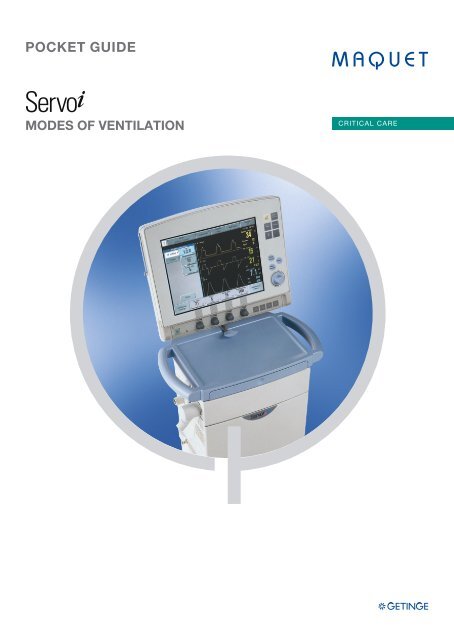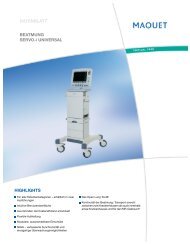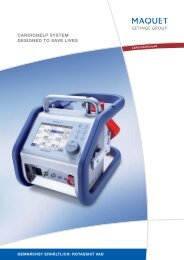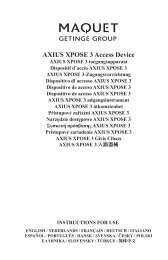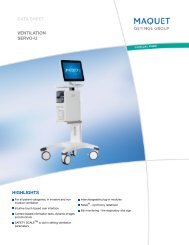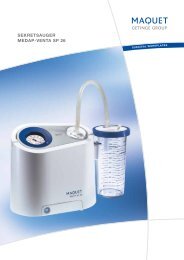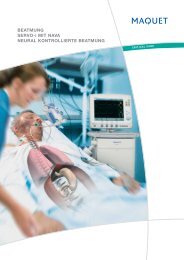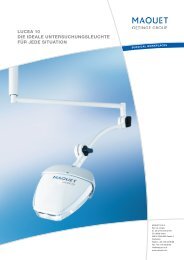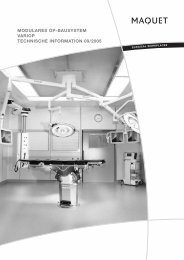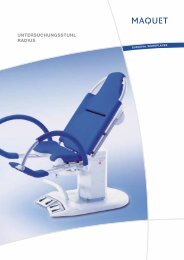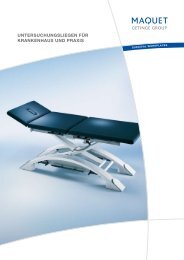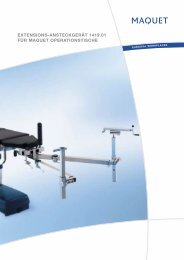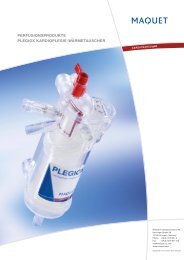Pocket Guide servo-i.indd - Maquet
Pocket Guide servo-i.indd - Maquet
Pocket Guide servo-i.indd - Maquet
Create successful ePaper yourself
Turn your PDF publications into a flip-book with our unique Google optimized e-Paper software.
POCKET GUIDE<br />
MODES OF VENTILATION<br />
CRITICAL CARE
CONTENT<br />
3 Content<br />
4 Introduction, Flow Pattern<br />
6 PEEP, Auto PEEP<br />
7 Inspiratory rise time, Cycle-off<br />
8 Trigger Sensitivity<br />
10 Volume Control – VC<br />
12 Pressure Control – PC<br />
14 Pressure Regulated Volume Control – PRVC<br />
16 Pressure Support – PS<br />
18 Continuous Positive Airway Pressure – CPAP<br />
19 Volume Support – VS<br />
23 Bi-Vent<br />
24 Automode ®<br />
26 Synchronized Intermittent Mandatory Ventilation – SIMV<br />
30 References<br />
3
INTRODUCTION TO MODES OF VENTILATION<br />
Mechanical ventilation is required when a patient is unable to achieve<br />
adequate ventilation and thereby gas exchange. The ventilation pattern<br />
must be adapted to suit the patient’s need for oxygenation and CO2<br />
elimination. The Servoi Ventilator system provides ventilation modes,<br />
which clinicians can tailor to the patient’s need.<br />
Note: This <strong>Pocket</strong> <strong>Guide</strong> only covers selected topics and cannot<br />
replace the User’s manual and the Service manual. For detailed<br />
information please always refer to the latest corresponding User’s<br />
manual and/or instructions for use.<br />
Abbreviations<br />
VC Volume Control<br />
PC Pressure Control<br />
PRVC Pressure Regulated Volume Control<br />
PS Pressure Support<br />
CPAP Continuous Positive Airway Pressure<br />
VS Volume Support<br />
SIMV Synchronized Intermittent Mandatory Ventilation<br />
Flow Pattern<br />
The Flow Pattern in Volume Control and SIMV (VC) is constant during<br />
inspiration. During the pause time the flow is zero.<br />
At the beginning of expiration, flow is large. It gets smaller and smaller<br />
and reaches zero by the end of expiration.<br />
Peak pressure<br />
Platau pressure<br />
End insp. flow<br />
End exp. pressure<br />
End exp. flow<br />
P resistance<br />
P compliance<br />
P = Pressure<br />
V = Flow<br />
V = Volume<br />
FLOW PATTERN<br />
In Pressure Control, Pressure Regulated Volume Control (PRVC), Pressure<br />
Support, Volume Support, SIMV (PRVC) with Pressure Support and SIMV<br />
(PC) with Pressure Support the flow is decelerating and the pressure is<br />
constant.<br />
Time Constant Valve Controller<br />
To reduce the resistance in the beginning of expiration the expiratory<br />
valve has a controlling algorithm, the Time Constant Valve Controller,<br />
which continuously calculates the elastic and resistive forces of the respiratory<br />
system. The initial opening of the expiratory valve is adapted<br />
to keep resistance as low as possible while strictly maintaining the set<br />
PEEP in the airway.<br />
4 5
6<br />
PEEP, AUTO PEEP<br />
PEEP<br />
A Positive End Expiratory Pressure is maintained in the alveoli to prevent<br />
the collapse of the airways. An “optimal PEEP level” has been used for a<br />
long time to protect the lung.<br />
Auto PEEP<br />
If the respiratory rate is set high or the expiratory time is not long enough<br />
there is a risk for auto PEEP. The patient does not have enough time to<br />
exhale and it is evident on the flow curve that flow will not return to zero<br />
before the next breath starts.<br />
There are different ways to check if the patient has an auto PEEP:<br />
• The flow will not go back to zero before next inspiration starts.<br />
• Vee is not zero, see 2nd page of Additional values on the User Interface.<br />
• Total PEEP = set PEEP + Auto PEEP, press Expiratory Hold to see total<br />
PEEP on 2nd page of Additional values on the User Interface.<br />
INSPIRATORY RISE TIME, CYCLE-OFF<br />
Inspiratory rise time<br />
Inspiratory rise time: Time to peak inspiratory flow or pressure at the<br />
start of each breath as a percentage of the respiratory cycle time or<br />
in seconds. The Inspiratory rise time is adjustable from a very fast<br />
response, where the patient basically performs only the triggering work,<br />
to a more controlled delivery, where the patient can interact during the<br />
inspiration.<br />
The Inspiratory flow profile has to<br />
be set to a comfortable value for<br />
the patient and can be evaluated<br />
by the shape of the flow and<br />
pressure curves. Inspiratory rise<br />
time % is applicable in all the<br />
controlled modes of ventilation<br />
(if configured for I:E ratio setting).<br />
Inspiratory rise time in seconds is<br />
applicable in Pressure Support,<br />
CPAP and Volume Support.<br />
Inspiratory Cycle-off<br />
Inspiratory Cycle-off is the point<br />
at which inspiration changes to<br />
expiration in spontaneous and<br />
supported modes of ventilation.<br />
It is important to set a proper<br />
Inspiratory Cycle-off to avoid hyperinflation<br />
of the lungs and increased<br />
work of breathing. If inspiration is<br />
too long, the patient tries to exhale<br />
by increasing the pressure and this<br />
may result in too short a time for expiration. This problem may give an<br />
Auto PEEP and increased work of breathing. Therefore it is important<br />
to check the pressure and flow curves e.g. if the end expiratory flow<br />
does not return to zero before next breath starts, the patient will have an<br />
Auto PEEP. If the Inspiratory Cycle-off cuts off inspiration too early, the<br />
patient will not get enough tidal volume.<br />
7
8<br />
TRIGGER SENSITIVITY<br />
Trigger Sensitivity<br />
This determines the level of patient effort to initiate the inspiratory flow,<br />
how much additional work of breathing the patient has to create to start<br />
the inspiration. A delay in gas delivery tends to increase the work of<br />
breathing. Trigger sensitivity can be set in flow or pressure triggering.<br />
Normally flow triggering is preferable as the work of breathing should<br />
be as low as possible, without self-triggering. Immediate sensing of<br />
inspiratory effort from the patient is mandatory in achieving synchronicity<br />
between the patient and the ventilator.<br />
The ventilator continuously delivers a flow during each expiration<br />
- In Adult the flow during expiration is 33 ml/sec (2 l/min)<br />
- In Infant the flow during expiration is 8 ml/sec (0.5 l/min)<br />
When the patient makes an inspiratory effort, the expiratory flow<br />
transducer in Servoi, senses a decrease in the continuous expiratory<br />
flow. When the difference between the inspiratory and expiratory<br />
flow equals the preset flow trigger level the ventilator will start a new<br />
inspiration.<br />
The flow Trigger sensitivity setting is<br />
divided in steps of 10%; each step<br />
increases Trigger sensitivity. In the red<br />
area the patient only has to inhale a very<br />
small part of the trigger flow to trigger a<br />
breath – risk for self triggering.<br />
The pressure Trigger sensitivity can be set<br />
within the range 0-20 cmH 2 O. To initiate<br />
a breath the patient has to create the<br />
negative pressure that is set as Trigger<br />
sensitivity. The higher the negative Trigger<br />
pressure is set on the ventilator, the<br />
more work of breathing the patient must<br />
perform. The Trigger sensitivity should<br />
be set as sensitive as possible without<br />
causing self triggering – auto triggering.<br />
TRIGGER SENSITIVITY<br />
When the patient triggers a breath a purple T appears between the text<br />
message and the alarm message areas. The initial part of the pressure or<br />
flow curves changes to purple to indicate when the patient triggers the<br />
breath. If the breath is flow-triggered the flow curve shows the purple<br />
color but if the breath is pressure-triggered, then the pressure curve<br />
shows the purple color.<br />
Each expiration delivers a continous<br />
flow. When the difference between<br />
the inspiratory and the expiratory<br />
flow equals the preset flow trigger<br />
level the Servoi will start a new<br />
inspiration.<br />
9<br />
9
10<br />
VOLUME CONTROL – VC<br />
Volume Control – VC<br />
In this controlled mode of ventilation the ventilator delivers the preset<br />
tidal volume with a constant flow during the preset inspiratory time with<br />
the preset pause time and at the preset respiratory rate.<br />
The Peak Pressure can vary from breath to breath if the patients<br />
Compliance and Resistance changes.<br />
If we have a tight system the inspired tidal volume should be the<br />
same as the expired tidal volume. The time for inspiration and expiration<br />
can be configured to be set in I: E ratio or in seconds.<br />
Example<br />
In Servoi you can select if you want to set the tidal volume or the minute<br />
volume. The flow during volume control ventilation is constant. The insp.<br />
time in % is seen in the information area in the menu Set ventilation<br />
mode. Inspiratory rise time: Time to peak inspiratory flow at start of each<br />
breath as a percentage of the respiratory cycle time.<br />
How to calculate the flow<br />
Example:<br />
Preset Insp. Min. Volume = 6 l/min<br />
Insp.time = 25%<br />
Gives inspiratory flow 6x100 =24 l/min<br />
25<br />
VC<br />
It is very important to set a sensitive triggering level to give the patient<br />
the possibility to breathe by himself as soon as possible. If the patient<br />
is making an inspiratory effort during the expiratory phase, he will get<br />
an assisted breath with the same tidal volume as set on the ventilator.<br />
Immediate sensing of inspiratory effort from the patient is mandatory in<br />
achieving synchronicity.<br />
In some cases, the patient may demand a higher tidal volume/flow than<br />
is set on the ventilator e.g. if the patient has pain, has an increased<br />
temperature, has change in the respiratory drive.<br />
The flow-adapted Volume Controller will always work with the patient<br />
and deliver the extra volume requested. If the patient decreases airway<br />
pressure by 2 cmH 2 O during the inspiratory phase the ventilator switches<br />
to Pressure Support and delivers a flow profile adapted to the patient’s<br />
immediate needs.<br />
Flow-adapted Volume Control<br />
11
12<br />
PRESSURE CONTROL – PC<br />
Pressure Control – PC<br />
In this controlled mode of ventilation the ventilator delivers a flow to<br />
maintain the preset pressure at a preset respiratory rate and during a<br />
preset inspiratory time.<br />
The pressure is constant during the inspiratory time and the flow<br />
is decelerating. If for any reason pressure decreases during inspiration<br />
the flow from the ventilator will immediately increase to maintain the set<br />
inspiratory pressure.<br />
The maximum available flow is 3.3 l/sec – 200 l/min for Adult and 0.56 l/sec –<br />
33 l/min for Infant. The volume can vary from breath to breath if the patient’s<br />
compliance and resistance changes. It is very important to set the alarm<br />
limits for expired minute volume to adequate levels.<br />
Inspiratory rise time in PC is the time to peak inspiratory pressure<br />
and flow of each breath. Settings can be in the range 0–20% of the<br />
respiratory cycle time - from an extremely fast response to a low initial<br />
inspiratory flow.<br />
Example:<br />
Respiratory rate 15, the time for 1 breath is 60/15 = 4 sec<br />
Inspiratory rise time 10% = 4x10 = 0.4 sec<br />
100<br />
PC<br />
The Servoi will sense the smallest deviations in pressure. A decrease in<br />
pressure will occur when there is a leakage in the breathing system, at<br />
the endotracheal tube, or in the lungs e.g. pneumothorax, fistula.<br />
When previously collapsed airways are starting to open the pressure<br />
decreases and the alveoli are opened by a precise increase in flow.<br />
Active expiratory valve<br />
If a patient tries to exhale during<br />
the inspiration, pressure increases.<br />
When it increases 3 cmH 2 O above<br />
the set inspiratory pressure level,<br />
the expiratory valve opens and<br />
regulates the pressure down to the<br />
set inspiratory pressure level.<br />
If the pressure increases to the set<br />
upper pressure limit e.g. the patient<br />
is coughing, the expiratory valve<br />
opens and the ventilator switches<br />
to expiration.<br />
13
PRESSURE REGULATED VOLUME CONTROL – PRVC<br />
Pressure Regulated Volume Control – PRVC<br />
PRVC is a controlled mode of ventilation which combines the advantages<br />
of Volume Controlled and Pressure Controlled Ventilation. The Servoi<br />
delivers the preset tidal volume with the lowest possible pressure. The<br />
first breath delivered to the patient is a Volume Controlled breath. The<br />
measured plateau pressure is used as the pressure level for the next<br />
breath.The pressure is constant during the set inspiratory time and the flow<br />
is decelerating. The set tidal volume is achieved by automatic, breathby-breath<br />
pressure regulation. The ventilator will adjust the inspiratory<br />
pressure control level, according to the mechanical properties of the<br />
airways/lung/thorax, to the lowest possible level to guarantee the preset<br />
tidal volume.<br />
14 15<br />
PRVC<br />
If the measured tidal volume increases above the preset, the pressure<br />
level decreases in steps of maximum 3 cmH 2 O between consecutive<br />
breaths until the preset tidal volume is delivered.<br />
If the measured tidal volume decreases below the preset, the pressure<br />
level increases in steps of maximum 3 cmH 2 O between consecutive<br />
breaths until the preset tidal volume is delivered.<br />
Maximum available pressure level is 5 cmH 2 O below preset upper<br />
pressure limit.<br />
If the pressure reaches 5 cmH 2 O below the upper pressure limit the<br />
ventilator will deliver as much volume as possible with this pressure.<br />
In the same time the information “Regulation Pressure Limited” (in the<br />
alarm message area) will inform the user that the set volume cannot be<br />
delivered with the set upper pressure limit. The alarm limit for expired<br />
minute volume will also alert the user if properly set.<br />
The Servoi will sense the smallest deviations in pressure. If it appears<br />
that previously collapsed units of the lung are starting to open in the late<br />
phase of inspiration the pressure tends to decrease, this is compensated<br />
by a precise increase in flow and the alveoli are opened.<br />
Terminal airway resistance decreases in discrete steps as pressure is<br />
applied. By immediately sensing the pressure drop that could be induced<br />
by an opening avalanche, Servoi provides proper flow to balance and<br />
further enhance the opening process.
PRESSURE SUPPORT – PS<br />
Pressure Support – PS<br />
This is a spontaneous mode of ventilation. The patient initiates the breath<br />
and the ventilator delivers support with the preset pressure level and a<br />
decelerating flow. The patient regulates the respiratory rate and the tidal<br />
volume with support from the ventilator.<br />
In Pressure Support the set inspiratory pressure support level is kept<br />
constant and there is a decelerating flow. The patient triggers all breaths.<br />
If the mechanical properties of the lung/thorax and patient effort change,<br />
delivered tidal volume will be affected. You then have to regulate the<br />
pressure support level to get the desired ventilation.<br />
The higher the preset inspiratory pressure level from the ventilator the<br />
more gas flows into the patient. As the patient becomes more active the<br />
pressure support level may be gradually reduced.<br />
The Trigger sensitivity has to be set properly for the patient without<br />
increase of the work of breathing. The patient has to inhale freely.<br />
The Inspiratory rise time has to be set to a comfortable value for the<br />
patient. This is the time to reach the peak inspiratory flow or pressure at<br />
the start of each breath in seconds.<br />
Normally in supported modes the Inspiratory rise time should be<br />
increased from the default settings and give more comfort to the<br />
patient.<br />
Inspiratory Cycle-off is the point at which inspiration changes to<br />
expiration. It is possible to set from 1% – 40% of inspiratory peak flow<br />
for both infants and adults.<br />
It is important that the inspiration and expiration is adapted to the patient.<br />
If the Cycle-off fraction is too short the patient will be left without proper<br />
support for a period of the breath. It is important to avoid phases with<br />
nearly no flow and late notches in the inspiratory flow curve. If this is the<br />
case, the Inspiratory Cycle-off should be increased.<br />
If the patient fails weaning it may be due to delayed termination of the<br />
inspiratory support. If the inspiratory part of the breath is prolonged, the<br />
patient will recruit his expiratory muscles and cycle the ventilator to expiration<br />
by an increase in pressure. This process utilizes patient energy and may<br />
shorten the time for expiration. This may induce Auto PEEP, increase work<br />
of breathing and cause lost trigger efforts by an increased internal threshold<br />
to triggering. In this case the Inspiratory Cycle-off should be increased. It is<br />
important to monitor the corresponding tidal volume levels.<br />
Pressure and flow curves<br />
Inspiration starts when the patient<br />
triggers a breath and gas flows into<br />
the patient’s lungs at a constant<br />
pressure. Since the pressure<br />
provided by the ventilator is<br />
constant, the flow will decrease<br />
until the Inspiratory Cycle-off is<br />
reached and then the expiration<br />
starts. Depending on how the Inspiratory<br />
rise time is set, the flow will<br />
be very fast rising or slower in the<br />
beginning of the breath.<br />
Expiration starts:<br />
- When the inspiratory flow decreases to the preset Inspiratory Cycle-off level.<br />
- If the upper pressure limit is exceeded.<br />
- If the inspiration exceeds 2.5 seconds in Adult range and 1.5 seconds in Infant.<br />
- If the flow drops to a flow range between 25% of the peak flow and lower<br />
limit for Inspiratory Cycle-off fraction level and the time spent within this<br />
range exceeds 50% of the time spent in between the start of the inspiration<br />
and the entering this range.<br />
16 17<br />
PS
PS, CONTINUOUS POSITIVE AIRWAY PRESSURE – CPAP VOLUME SUPPORT – VS<br />
If the apnea alarm limit is reached the ventilator will automatically switch<br />
to the Back-up Mode, Pressure Controlled Ventilation. The Inspiratory<br />
Pressure level can be set from 5 to 120 cmH 2 O - PEEP for Adult and 5<br />
to 80 cmH 2 O - PEEP for Infant and as default is 20 cmH 2 O for Adult and<br />
10 cmH 2 O for Infant. The I: E ratio, Respiratory Rate and Inspiratory rise<br />
time are set to the default settings. Alarms will alert staff of the change,<br />
the User Interface will display the message “Ventilating in Back-up<br />
Mode. Change mode or go back to support mode!”<br />
The user has to decide if the patient can breath spontaneously or not and<br />
the user has to select:<br />
- Support mode<br />
- Change mode<br />
Continuous Positive Airway Pressure – CPAP<br />
The mode Continuous Positive Airway Pressure is used when the patient<br />
is breathing spontaneously. CPAP works in exactly the same way as<br />
Pressure Support, but the pressure support level is set to zero.<br />
Volume Support – VS<br />
Volume Support is a spontaneous mode; the patient has to initiate the<br />
breath and the ventilator delivers support in proportion to the inspiratory<br />
effort and the target volume. This mode of ventilation avoids ventilator<br />
induced hyperinflation, but compensates and adapts to changes in<br />
respiratory load. The set tidal volume will be delivered to the patient with<br />
different support from the ventilator depending on the patient’s activity.<br />
If the patient’s activity increases the Inspiratory pressure support will<br />
decrease provided the set tidal volume is maintained. If the patient<br />
breathes below the set tidal volume the inspiratory pressure support will<br />
increase. The inspiratory flow will be decelerating.<br />
The start-up sequence is 4 breaths. The first breath is given with a<br />
support of 10 cmH 2 O. From that breath the ventilator continually<br />
calculates and regulates the pressure needed to deliver the preset tidal<br />
volume. During the remaining 3 breaths, the maximum pressure increase<br />
is 20 cmH 2 O for each breath. After the start-up sequence, if the delivered<br />
18 19
VS<br />
tidal volume is below the set tidal volume the pressure support level is<br />
increased in steps of maximum 3 cmH 2 O breath by breath until the<br />
preset tidal volume is delivered. If the delivered tidal volume is above<br />
the set tidal volume the pressure support level is decreased in steps of<br />
maximum 3 cmH 2 O until the preset tidal volume is delivered.<br />
The inspiratory pressure support level automatically adapts to changes<br />
in lung/thorax mechanical properties and patient effort. To evaluate the<br />
patient’s own work of breathing it is easy to go into the trend and look<br />
at the airway pressure. When the airway pressure declines, the patient is<br />
taking over more of the respiratory work.<br />
By combining Volume Support with compressible volume compensation,<br />
flow variations which can induce high pressure drops across the<br />
endotracheal tube are compensated for on-line by a proper increase in<br />
pressure delivery.<br />
The Inspiratory rise time has to be set to a comfortable value for the<br />
patient. This is the time to reach the peak inspiratory flow or pressure at<br />
the start of each breath in seconds. Normally in supported modes the<br />
Inspiratory rise time should be increased from the default settings and<br />
thus give more comfort to the patient. Inspiratory Cycle-off is the point at<br />
which inspiration changes to expiration.<br />
It’s important that the inspiration<br />
and expiration is adapted to the<br />
patient. If the Cycle-off fraction<br />
is too short the patient will be left<br />
without proper support for a period<br />
of the breath. It’s also important to<br />
avoid phases with nearly no flow<br />
and late notches in the inspiratory<br />
flow curve. If this is the case,<br />
Inspiratory Cycle-off should be<br />
increased.<br />
If the patient fails weaning it may be due to delayed termination of the<br />
inspiratory support. If the inspiratory part of the breath is prolonged,<br />
the patient will recruit his expiratory muscles and cycle the ventilator to<br />
expiration by an increase in pressure.<br />
This process utilizes patient energy and may shorten the time for<br />
expiration. This may induce Auto PEEP, increase work of breathing and<br />
cause lost trigger efforts by an increased internal threshold to triggering.<br />
In this case the Inspiratory Cycle-off should be increased.<br />
Pressure and flow curves<br />
Inspiration starts when the patient triggers a breath and gas flows into<br />
the patient’s lungs at a constant pressure. Since the pressure provided<br />
by the ventilator is constant, the flow will decrease until the Inspiratory<br />
Cycle-off is reached and then the expiration starts.<br />
Depending on how the Inspiratory rise time is set, the flow will be very<br />
fast rising or slower in the beginning of the breath.<br />
Expiration starts:<br />
- When the inspiratory flow decreases to the preset Inspiratory Cycle-off level.<br />
- If the upper pressure limit is exceeded.<br />
- If the inspiration exceeds 2.5 seconds in Adult range and 1.5 seconds in Infant.<br />
- If the flow drops to a flow range between 25% of the peak flow and lower<br />
limit for Inspiratory Cycle-off fraction level and the time spent within this<br />
range exceeds 50% of the time spent in between the start of the inspiration<br />
and the entering this range.<br />
20 21<br />
VS
22<br />
VS<br />
If the apnea alarm limit is reached the ventilator will automatically switch<br />
to the Back-up Mode, Volume Controlled Ventilation, with the same tidal<br />
volume as in Volume Support. During Back-up ventilation default settings<br />
are used for I:E ratio, Respiratory rate and Inspiratory rise time.<br />
Alarms will alert staff of the change, the User Interface will display the<br />
message“Ventilating in Back-up Mode. Change mode or go back to<br />
support mode!”<br />
The user has to decide if the patient can breathe spontaneously or not<br />
and the user has to select: Support mode or Change mode.<br />
Bi-Vent<br />
The Bi-Vent mode is a pressure<br />
controlled breathing mode giving<br />
the patient the opportunity for unrestricted<br />
spontaneous breathing.<br />
In this mode the ventilator uses<br />
two shifting pressure levels and<br />
the patient can breathe spontaneously<br />
at both these levels. It<br />
is also possible to support the<br />
patient with Pressure Support at<br />
both pressure levels.<br />
BI-VENT<br />
Example:<br />
Phigh is set to 2 sec and PEEP is set to 4 sec and this will give you 6<br />
sec for the Bi-Vent cycle. The mandatory rate will be 60/6 = 10 breaths<br />
per minute. The Bi-Vent cycle may be shifted somewhat depending on<br />
the patient and the ventilator settings since the ventilator continuously<br />
synchronizes with the patient’s breathing. Since Bi-Vent is a controlled<br />
mode of ventilation, back-up ventilation is not available.<br />
Every Bi-Vent cycle has time for the P high and for the PEEP level. The time for P high can<br />
be set 0.2 – 10 sec and the time for PEEP can be set 0.2 – 10 sec. This means that you<br />
can set the mandatory rate from 3-150 breaths per minute.<br />
23
24<br />
AUTOMODE ®<br />
Automode ®<br />
Automode is an interactive mode of ventilation. The combined control<br />
and support function of the ventilator adapts to the patient’s breathing<br />
capacity. Automode allows the patient to go into a support mode<br />
automatically if he triggers the ventilator, thereby better adapting<br />
ventilation to patient effort. If the patient is not making any breathing<br />
effort the ventilator will deliver controlled breaths.<br />
Automode gives both the patient and clinician an optimal means of<br />
commencing the weaning period at the time of initiating ventilator therapy.<br />
Essentially the ventilator works in two modes: control or support.<br />
When the patient, in control mode, makes an inspiratory effort, the<br />
ventilator reacts by supplying a supported breath.<br />
Three different coupling modes combining control and support are available:<br />
Volume Control Volume Support<br />
PRVC Volume Support<br />
Pressure Control Pressure Support<br />
AUTOMODE ®<br />
The start-up algorithm for Automode will protect against false triggering.<br />
The ventilator initially adapts with the adjustable Trigger Timeout. Trigger<br />
Timeout is the maximum allowed apnea time in Automode before<br />
controlled ventilation is activated. This means that for the spontaneously<br />
breathing patient the Trigger Timeout limit increases successively.<br />
The patient has to breathe 10 breaths in a row before the ventilator will<br />
wait the whole Trigger Timeout period before switching to controlled<br />
ventilation. If the patient triggers fewer breaths the ventilator will<br />
decrease the time when it switches to controlled ventilation. The time<br />
before the ventilator switches from support to controlled ventilation<br />
will be shorter and shorter the fewer breaths the patient triggers. If the<br />
patient breathes more than 10 breaths in a row and then stops it will take<br />
the set Trigger Timeout, e.g. 7 seconds, before the ventilator initiates<br />
controlled ventilation.<br />
Patient activity can be seen by looking at the trend, which will indicate<br />
the activity of the patient over 24 hours.<br />
Early detection and adaptation to patient effort promotes spontaneous<br />
breathing and early weaning. At the first sensing of spontaneous effort,<br />
Automode delivers supported breaths adapted to patient’s effort, instead<br />
of a controlled mechanically pre-programmed pattern.<br />
25
26<br />
SYNCHRONIZED INTERMITTENT MANDATORY VENTILATION<br />
Synchronized Intermittent Mandatory Ventilation – SIMV<br />
During SIMV the patient receives mandatory breaths controlled by the<br />
ventilator. These mandatory breaths are synchronized with the breathing<br />
efforts of the patient. The patient can breathe spontaneously in between<br />
the mandatory breaths. The spontaneous/pressure supported breath is<br />
defined by setting the Pressure Support level above PEEP.<br />
There are three different SIMV modes:<br />
- SIMV Volume Control and Pressure Support<br />
- SIMV Pressure Control and Pressure Support<br />
- SIMV PRVC and Pressure Support<br />
SIMV VC + Pressure Support<br />
SIMV PC + Pressure Support<br />
SIMV PRVC + Pressure Support<br />
SIMV<br />
SIMV(VC)+PS SIMV(PRVC)+PS SIMV(PC)+PS<br />
PC above PEEP X<br />
tidal volume /<br />
X X<br />
minute volume<br />
SIMV rate X X X<br />
Breath cycle time X1 X1 X1 I:E ratio /<br />
X X X<br />
Inspiration time<br />
Inspiratory rise time X X X<br />
Pause time X<br />
1 Only when the ventilator is configured for I:E ratio setting<br />
The mandatory breath is defined by the basic settings (as shown in table above): minute<br />
volume/tidal volume (depending on configuration), PC above PEEP, I:E ratio, Inspiration<br />
time (depending on configuration), Pause time, Inspiratory rise time and Breath cycle<br />
time.<br />
Note: In the minute volume configuration the tidal volume is determined by minute<br />
volume divided by SIMV rate.<br />
27
28<br />
SIMV<br />
Breath Cycle Time (Breath Cycle T)<br />
This is the length of the total respiratory cycle of the mandatory breath.<br />
The total time for inspiration, pause and expiration.<br />
Note: This is if the Servoi is configured for setting the inspiratory time by<br />
setting the I:E ratio.<br />
The SIMV cycle in seconds is calculated as follows: 60 seconds divided<br />
by the SIMV rate. The SIMV cycle is divided into a SIMV period and a<br />
spontaneous period.<br />
Example:<br />
Following settings are made:<br />
SIMV rate 6<br />
Breath Cycle time 3 sec<br />
I:E ratio 1:2<br />
The time for the mandatory breath is<br />
3 sec = SIMV period<br />
I:E ratio 1:2 = 1 sec for inspiration,<br />
2 sec for expiration<br />
The time for one SIMV cycle is 60 sec divided by the<br />
set SIMV rate. In this example 60/6 = 10 sec<br />
The time for the spontaneous period is 10-3 = 7 sec<br />
SIMV<br />
If the patient is not breathing at all only the mandatory breaths will be<br />
delivered. When the patient starts to breathe he will get the Pressure<br />
Support in the spontaneous period and if triggering in the SIMV period<br />
the set mandatory breath will be delivered. In the next SIMV period the<br />
ventilator will wait for the patient to trigger but if the patient has not<br />
triggered within the first 90% of the breath cycle time (SIMV period) a<br />
mandatory breath will be delivered.<br />
29
30<br />
REFERENCES AND SUGGESTED READING<br />
Amato MB, Barbas CS, Medeiros DM,<br />
et al. Effect of a protective-ventilation<br />
strategy on mortality in the acute<br />
respiratory distress syndrome. N Engl J<br />
Med 1998; 338:347-54.<br />
Böhm S, Lachmann B. Pressurecontrol<br />
ventilation. Putting a mode into<br />
perspective. Int J Int Care 1996;3:12-27<br />
Paul E. Marik, MD; and Jim Krikorian,<br />
RRT. Pressure-Controlled Ventilation<br />
in ARDS: A Practical Approach. Chest<br />
1997; 112:1102-6.<br />
Suter PM, Fairley HB, Isenberg MD.<br />
Optimum end-expiratory airway pressure<br />
in patients with acute pulmonary failure.<br />
N Engl J Med 1975; 292:284–289.<br />
Hickling KG, Walsh J, Henderson S, et<br />
al: Low mortality rate in adult respiratory<br />
distress syndrome using low-volume,<br />
pressure-limited ventilation with<br />
permissive hypercapnea: A prospective<br />
study. Crit Care Med 22:1568-1578, 1994<br />
Esteban A, Alia I, Gordo F, et al.<br />
Prospective Randomized Trial Comparing<br />
Pressure-Controlled Ventilation and<br />
Volume-Controlled Ventilation in ARDS.<br />
Chest 2000; 117:1690–1696.<br />
Ranieri M, Giuliani R, Fiori T, et al.:<br />
Volume-pressure curve of the respiratory<br />
system predicts effects of PEEP in<br />
ARDS: “occlusion” versus “constant<br />
flow” technique. Am J Respir Crit Care<br />
Med 1994, 149:19–27.<br />
H Roth, M Quintel, R Tillmans, et al.:<br />
Interactive ventilation: first experience<br />
with patient controlled weaning by using<br />
a Siemens –SV300 Automode ventilator.<br />
Crit Care 1998,2 (suppl 1):P81<br />
Masaji Nishimura, Dean Hess, and Robert<br />
M. Kacmarek. The Response of Flowtriggered<br />
Infant Ventilators. Am J Crit<br />
Care Med Vol 152. pp 1901-1909, 1995<br />
Holt SJ, Sanders RC, Thurman TL,<br />
Heulitt MJ. An evaluation of Automode,<br />
a computer-controlled ventilator mode,<br />
with the Siemens Servo 300A ventilator,<br />
using a porcine model. Respir Care 2001<br />
Jan;46 (1):26-36<br />
Marini JJ. Pressure-targeted, lungprotective<br />
ventilatory support in acute<br />
lung injury. Chest 1994: 105: 109S–115S.<br />
A. Piotrowski MD, W. Sobala MD, et al.<br />
Patient-initiated, pressure-regulated,<br />
volume-controlled ventilation compared<br />
with intermittent mandatory ventilation<br />
in neonates: a prospective, randomised<br />
study. Int.Care Med (1997) 23: 975-981<br />
Keenan Heather, MD, Martin Lynn, MD,<br />
Volume Support Ventilation in Infants<br />
and children: Analysis of a Case Series.<br />
Respir. Care 1997;3:281 – 287.<br />
Ramet J., Suvs B., et al. Weaning<br />
Outcome in Children According to<br />
the Pre-weaning ventilatory Modes.<br />
Respiratory and Critical Care Medicine,<br />
1995;151(4):A424.<br />
Ramet J., Idrissi S., et al. The Effects<br />
of Pressure Regulated Volume Control<br />
Ventilation on Sedation Requirements.<br />
Respiratory and Critical Care Medicine,<br />
1995;151(4):A744.<br />
Apostolakos Michael J., MD, Levy Paul<br />
C. MD. et al. New Modes of Mechanical<br />
Ventilation.<br />
Clin Pulm Med 1995;2:121-128.<br />
Hazelzet Jan A. MD, Petru Ronald MD. et<br />
al. New Modes of Mechanical Ventilation<br />
for Severe Respiratory Failure. Critical<br />
Care Medicine 1993;9(Suppl.):S366-<br />
S367.<br />
Tremblay LN., Slutsky AS., The role of<br />
pressure and volume in ventilator induced<br />
lung injury. Applied Cardiopulmonary<br />
Pathophysiology. 1996 6:179-190.
<strong>Maquet</strong> Critical Care AB<br />
SE-171 95 SOLNA<br />
Sweden<br />
Phone: +46 8 730 73 00<br />
www.maquet.com/criticalcare<br />
Not for circulation in the USA.<br />
© <strong>Maquet</strong> Critical Care AB 2003. All rights reserved.<br />
MAQUET reserves the right to modify the design and<br />
specifications contained herein without prior notice.<br />
Order No. 66 14 692 E315E<br />
Printed in Sweden<br />
WS 1203 5.<br />
Rev.01 English<br />
December 2003<br />
Price: Group 1


